
Historic Replica of the World’s First Truck Undergoes Restoration Ahead of 130th Anniversary
For many employees and visitors to the Daimler Truck Campus in Leinfelden-Echterdingen, the sight of the world’s first truck—or rather, a meticulously constructed replica of it—is a familiar one. Positioned prominently in the lobby of Daimler Truck’s headquarters, the exhibit serves as both a tribute to automotive innovation and a symbol of the company’s rich heritage. But this summer, the famed vehicle is taking a break from its usual post. With the onset of summer holidays in the German state of Baden-Württemberg, the replica is temporarily leaving the display floor to undergo an extensive remanufacturing and restoration process.
This historic replica, which will celebrate its 130th anniversary in 2026, is widely recognized as a milestone in the evolution of the commercial vehicle industry. Rather than simply preserving it as a static museum piece, Daimler Truck has opted to breathe new life into the truck through a collaborative technical restoration project. The goal is clear: ensure that the vehicle is not only preserved in form but also fully operational, able to drive under its own power just as it did when it first revolutionized transportation over a century ago.
To carry out this delicate task, the truck has been transported to the Philipp-Matthäus-Hahn-Schule in Nürtingen, a vocational school renowned for its specialized training in the maintenance and restoration of classic and vintage vehicles. Situated within the Stuttgart region—Germany’s heartland of automotive engineering—the school has become a hub for preserving automotive history while equipping young professionals with the skills needed to maintain it.
At the core of this restoration project is a unique educational collaboration. Under the guidance of seasoned instructors, automotive apprentices who are undergoing additional qualifications in classic and modern classic car mechanics will take part in the restoration. This initiative represents a fusion of heritage, education, and craftsmanship—where seasoned expertise meets youthful enthusiasm and technical training.
The Philipp-Matthäus-Hahn-Schule places great emphasis on authenticity, particularly when it comes to vintage and heritage vehicles. The team working on the truck aims to maintain historical accuracy while applying modern mechanical precision. Every component of the truck, from its wooden chassis to its early combustion engine mechanics, will be carefully assessed, repaired, or remanufactured in keeping with the original design. Where feasible, traditional tools and techniques will be employed, ensuring the vehicle retains the look and feel of its late-19th-century origins.
According to instructors involved in the project, the remanufacturing process goes beyond simple cosmetic work. The objective is to make the vehicle fully operational again, a goal that demands both historical knowledge and contemporary engineering skills. This effort not only pays tribute to the truck’s original creators but also reinforces the value of technical education and intergenerational knowledge transfer.
The truck is expected to return to Leinfelden-Echterdingen by the end of August 2025, just in time to be showcased at the Spitzkraut Classics, a regional classic vehicle event taking place in the fall. However, the truck’s role at the event will go beyond mere display. In a celebration of its legacy, it will be driven—highlighting the success of the restoration and giving attendees a firsthand experience of what early automotive innovation looked and felt like.
For Daimler Truck, this restoration is more than just a technical exercise—it’s a narrative that connects the company’s past, present, and future. In a world of rapidly evolving vehicle technology, from electric trucks to autonomous systems, the project serves as a reminder of how far the commercial vehicle sector has come. At the same time, it reinforces the importance of preserving mechanical heritage and passing on the craft of vehicle building to new generations.
The initiative also underscores the company’s broader commitment to education and craftsmanship. By involving apprentices in such a historically significant project, Daimler Truck and the Philipp-Matthäus-Hahn-Schule are actively investing in the next generation of skilled tradespeople—those who will both carry forward the legacy of vehicle engineering and shape its future.
As the 130th anniversary of the original truck approaches, this remanufacturing effort transforms a static exhibit into a living, moving symbol of innovation, continuity, and education. When it rolls once again under its own power later this year, it will do so not just as a relic of the past, but as a renewed testament to the enduring spirit of technical ingenuity.




